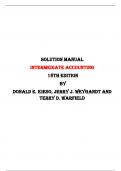Exam (elaborations)
Solution Manual for Intermediate Accounting, 18th Edition by Donald E. Kieso, Jerry J. Weygandt and Terry D. Warfield. | Chapter 1 – 24, Latest-2023/2024|
- Module
- Institution
- Book
Solution Manual for Intermediate Accounting, 18th Edition by Donald E. Kieso, Jerry J. Weygandt and Terry D. Warfield. | Chapter 1 – 24, Latest-2023/2024|
[Show more]



